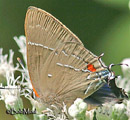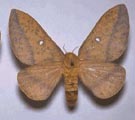Native Plants
Search for native plants by scientific name, common name or family. If you are not sure what you are looking for, try the Combination Search or our Recommended Species lists.
Quercus virginiana
Quercus virginiana Mill.
Coastal Live Oak, Southern Live Oak, Virginia Live Oak, Live Oak, Encino
Fagaceae (Beech Family)
Synonym(s):
USDA Symbol: quvi
USDA Native Status: L48 (N)
An open-grown live oak is a massive, picturesque, wide-spreading tree with magnificent horizontal and arching branches that form a broad, rounded canopy. A squat, tapering trunk (larger in diameter than that of any other oak) supports the huge, irregular limbs which often rest their elbows on the ground. Dimensions are 40-80 ft. in height and 60-100 ft. in width. Dark-green, waxy, unlobed leaves fall just as new leaves emerge in the spring, making the tree appear evergreen, though the coordinated leaf loss means it's not actually a true evergreen.
This is the familiar Spanish moss-covered oak of plantations in southeastern North America. Its massive limbs and persistent, glossy foliage have sustained its popularity as a residential shade tree to the present day. It is rarely found inland except in cultivation, where it becomes semi-deciduous and slower growing than those that receive the moisture-laden winds of the coast. Adequate water is essential to maintaining this tree, though it is fairly drought-tolerant once established within its range. It is, however, quite susceptible to oak wilt where that is a problem, so treating surface wounds and avoiding damage to the roots is important. Though this is the best known live oak, there are a few North American live oak species also popular in residential landscaping, including on the West Coast, California Live Oak (Quercus agrifolia Née), and, in southern Oklahoma, central Texas, and northeastern Mexico, Escarpment Live Oak (Q. fusiformis Small), sometimes regarded as a mere variety of Q. virginiana but currently considered a distinct species. Escarpment live oak has slightly smaller leaves, broadest toward the base, and acorns with cups narrowed at the base (fusiform). It is more drought-tolerant than Q. virginiana and is commonly planted in drier parts of Texas. Both Q. virginiana and Q. fusiformis may send up dense shoots near or far from the trunk from rhizomes, sometimes so thickly that when mowed it looks like a groundcover.
Plant Characteristics
Duration: PerennialHabit: Tree
Leaf Retention: Deciduous
Leaf Arrangement: Alternate
Leaf Complexity: Simple
Leaf Shape: Elliptic , Obovate
Leaf Venation: Pinnate
Leaf Margin: Entire
Leaf Apex: Acute
Leaf Base: Cuneate , Rounded
Breeding System: Flowers Unisexual , Monoecious
Inflorescence: Catkin
Fruit Type: Nut
Size Notes: Normally 40-50 ft tall, but can reach 80 ft.
Leaf: Though this species appears to be evergreen, it is actually deciduous, late each winter dropping its old leaves just as new ones emerge.
Flower: Flowers borne on 2-3" aments (catkins).
Fruit: Dark brown 1/3 to 1/2 inch acorns.
Bloom Information
Bloom Color: YellowBloom Time: Mar , Apr , May
Distribution
USA: AL , FL , GA , LA , MS , NC , SC , TX , VANative Distribution: Coastal areas from southeast VA south to FL and western Cuba, west to east TX
Native Habitat: Sandy, coastal plains; moist hammocks
Growing Conditions
Water Use: MediumLight Requirement: Sun , Part Shade
Soil Moisture: Moist
CaCO3 Tolerance: None
Heat Tolerant: yes
Soil Description: Dry to moist soils, whether gravelly, sandy, loamy or clay, but does best in neutral or slightly acidic clay loams; poor drainage okay. Saline tolerant and tolerant of compaction.
Conditions Comments: The species tolerates more shade in summer than most oaks because the evergreen leaves can function through most of the winter. Can be damaged by long periods of freezing weather. Fairly drought tolerant once established, but susceptible, among other things, to oak wilt and chestnut blight.
Benefit
Use Ornamental: A very large, long-lived, evergreen shade tree.Use Wildlife: Many species of birds as well as squirrels use the tree for cover and the acorns for food.
Use Medicinal: The Houma used some preparation from it to treat dysentery.
Use Other: Live oak timber was once important for building ships. The nation's first publicly owned timber lands were purchased as early as 1799 to preserve these trees for this purpose.
Conspicuous Flowers: yes
Interesting Foliage: yes
Attracts: Birds , Butterflies
Larval Host: Horace's Duskywing, White M hairstreak, Northern hairstreak.
Butterflies and Moths of North America (BAMONA)
|
White M Hairstreak (Parrhasius m-album)  Larval Host |
Consular oakworm moth (Anisota consularis)  Larval Host |
Propagation
Propagation Material: SeedsDescription: Oaks are most often propagated from seed. No pretreatment is necessary. Plant immediately – outdoors or in deep containers to accommodate long initial taproot. Protect outdoor beds with wire mesh to deter rodent predation.
Seed Collection: Best quality acorns are picked or shaken from the tree. Collect when color has changed to brown. Best if sown immediately as acorns lose viability quickly in storage. Short-term storage in moist, shaded saw dust or sand.
Seed Treatment: Acorns to be sown immediately can be soaked in hot water for 15 min. to prevent weevil infestation. Stored seed should be fumigated with methyl bromide.
Commercially Avail: yes
Maintenance: Prevent complete soil dryness. Prune to maintain shape. May be pruned 12 mo. out of the year. Fertilize 3 times a year with lawn fertilizer 3:1:2 ratio. Young trees grow quickly and need to be trained if their natural tendency to sprawl is unwelcome.
Find Seed or Plants
View propagation protocol from Native Plants Network.
Mr. Smarty Plants says
Eucalyptus tree for Spring, Texas
October 31, 2008
I've heard eucalyptus trees do not lose their leaves in the winter and grow considerably tall. I want to replace a decaying pine tree with a eucalyptus tree. Do you recommend that for the Spring, T...
view the full question and answer
Native trees for cemetery plot in Karnes County, TX
April 08, 2007
I'm looking for a tree for a cemetery plot in Karnes County at Pana Maria. There will be someone to regularly water it. I understand live oak and pecan are native to the area. I assume these would...
view the full question and answer
National Wetland Indicator Status
| Region: | AGCP | AK | AW | CB | EMP | GP | HI | MW | NCNE | WMVE |
| Status: | FACU | FACU | FACU | FACU | UPL |
From the National Organizations Directory
According to the species list provided by Affiliate Organizations, this plant is on display at the following locations:Texas Discovery Gardens - Dallas, TX
Sibley Nature Center - Midland, TX
Brackenridge Field Laboratory - Austin, TX
Crosby Arboretum - Picayune, MS
Texas Parks and Wildlife Department - Austin, TX
Georgia Native Plant Society - Atlanta, GA
Texas Master Naturalists - Lost Pines Chapter - Bastrop, TX
Wellspring Organic Farm and Education Center - West Bend, WI
Bibliography
Bibref 766 - Dale Groom's Texas Gardening Guide (2002) Groom, D.Bibref 1186 - Field Guide to Moths of Eastern North America (2005) Covell, C.V., Jr.
Bibref 298 - Field Guide to Texas Trees (1999) Simpson, B.J.
Bibref 1185 - Field Guide to Western Butterflies (Peterson Field Guides) (1999) Opler, P.A. and A.B. Wright
Bibref 1620 - Gardening with Native Plants of the South (Reprint Edition) (2009) Wasowski, S. with A. Wasowski
Bibref 481 - How to Grow Native Plants of Texas and the Southwest: Revised and Updated Edition (2001) Nokes, J.
Bibref 355 - Landscaping with Native Plants of Texas and the Southwest (1991) Miller, G. O.
Bibref 841 - Native Alternatives to Invasive Plants (2006) Burrell, C. C.
Bibref 318 - Native Texas Plants: Landscaping Region by Region (2002) Wasowski, S. & A. Wasowski
Bibref 291 - Texas Wildscapes: Gardening for Wildlife (1999) Damude, N. & K.C. Bender
Bibref 297 - Trees of Central Texas (1984) Vines, Robert A.
Search More Titles in Bibliography
From the Archive
Wildflower Newsletter 1986 VOL. 3, NO.4 - Fall Highlights Busy Season at the Center, Wildflower Days Welcome the Holidays,...Wildflower Newsletter 1989 VOL. 6, NO.5 - Educator\\\'s Native Plants Poster Perfected, Pass a Law, Protect a Tree, Resear...
Wildflower Newsletter 1998 VOL. 15, NO.6 - Landscaping with Native Trees, Society for Ecological Restoration Conference Rev...
Additional resources
USDA: Find Quercus virginiana in USDA PlantsFNA: Find Quercus virginiana in the Flora of North America (if available)
Google: Search Google for Quercus virginiana
Metadata
Record Modified: 2015-11-05Research By: TWC Staff, GDG